Introduction
In this example, we check the correctness of SFEMaNS for a magnetohydrodynamic problem with variable electrical conductivity involving Dirichlet boundary conditions. The mass equation is not approximated. We consider a level set, solution of the same advection equation, that is used to reconstruct the density and the other fluid's properties.
We solve the level set equation:
\begin{align*} \partial_t \varphi + \bu \cdot \GRAD \varphi = f_\varphi. \end{align*}
We recontruct the density, dynamical viscosity and electrical conductivity as follows:
\begin{align*} \rho=\rho_1+(\rho_2-\rho_1) F(\varphi), \\ \eta=\eta_1+(\eta_2-\rho_1) F(\varphi), \end{align*}
with \(\eta_i\) and \(\rho_i\) data to define. The function \(F(\varphi)\) is either the identity (called linear reconstruction) or a piece-wise polynomial function (called reg reconstruction).
We solve the Navier-Stokes equations with the momentum \(\bm=\rho\bu\) as dependent variable:
\begin{align*} \partial_t\bm + \DIV(\bm\otimes\bu) - \frac{2}{\Re} \DIV(\eta \epsilon(\bu)) +\GRAD p &=\bef + (\ROT \textbf{H}) \times (\mu^c \textbf{H}), \\ \DIV \bu &= 0, \\ \bu_{|\Gamma} &= \bu_{\text{bdy}} , \\ \bu_{|t=0} &= \bu_0, \\ p_{|t=0} &= p_0, \end{align*}
where \(\epsilon(\bu)=\frac{1}{2}(\GRAD \bu + \GRAD^s \bu)\) is the strain rate tensor.
We solve the Maxwell equations:
\begin{align*} \partial_t (\mu^c \mathbf{H}) + \nabla \times \left(\frac{1}{\Rm \sigma}\nabla \times \mathbf{H} \right) & = \nabla\times (\bu \times \mu^c \mathbf{H}) + \nabla \times \left(\frac{1}{\Rm \sigma} \nabla\times \mathbf{j} \right), \\ \text{div} (\mu^c \mathbf {H}) &= 0 ,\\ {\bH \times \bn}_{|\Gamma} &= {\bH_{\text{bdy}} \times \bn}_{|\Gamma},\\ \bH_{|t=0}&= \bH_0. \end{align*}
These equations are solved in the domain \(\Omega= \{ (r,\theta,z) \in {R}^3 : (r,\theta,z) \in [0,1/2] \times [0,2\pi) \times [0,1]\} \) with \(\Gamma= \partial \Omega \). The data are the source terms \(f_\varphi\), \(\bef\) and \(\textbf{j}\), the boundary data \(\bu_{\text{bdy}}\), the initial datas \(\bu_0\) and \(p_0\). The parameter \(\Re\) is the kinetic Reynolds number$, the magnetic Reynolds number \(\Rm\), the magnetic permeability \(\mu^c\), the densities \(\rho_i\), the dynamical viscosities \(\eta_i\) and the electrical conductivities \(\sigma_i\).
Remarks:
-
The level set and the momentum equations can be stabilized with the entropy viscosity method used in test 15 (called LES).
-
For physical problem, the level set has to take values in [0,1] such that the interface is represented by \(\varphi^{-1}(\{1/2\})\). The fluids area are respectively represented by \(\varphi^{-1}(\{0\})\) and \(\varphi^{-1}(\{1\})\). This test does not consider immiscible fluids. It involves manufactured solution with a smooth variable density. As a consequence, the level set does not take values in [0,1].
-
A compression term can also be added in the level set equation. This term allows the level set to remains sharp near the fluids interface represented by \( \varphi^{-1}(\{1/2\}) \).
We refer to the section Extension to multiphase flow problem for more details on the algorithms implemented in SFEMaNS for multiphase problem.
Manufactured solutions
We approximate the following analytical solutions:
\begin{align*} u_r(r,\theta,z,t) &= 0, \\ u_{\theta}(r,\theta,z,t) &= 0 , \\ u_z(r,\theta,z,t) &=0 , \\ p(r,\theta,z,t) &= 0, \\H_r(r,\theta,z,t) &= r^3 , \\H_{\theta}(r,\theta,z,t) &= 0 , \\H_z(r,\theta,z,t) &= - 4 r^2 z , \\ \varphi(r,\theta,z,t) &=1 + z + r \cos(\theta), \\ \rho(r,\theta,z,t) &=2 + z + r \cos(\theta), \\ \eta(r,\theta,z,t) &=1, \\ \sigma(r,\theta,z,t) &=2 + z + r \cos(\theta). \end{align*}
where the source terms \(f_\varphi\), \(\bef\), \(\textbf{j}\) and the boundary data \( \bu_{\text{bdy}}\) are computed accordingly.
Generation of the mesh
The finite element mesh used for this test is named Mesh_10_form.FEM and has a mesh size of \(0.1\) for the P1 approximation. You can generate this mesh with the files in the following directory: ($SFEMaNS_MESH_GEN_DIR)/EXAMPLES/EXAMPLES_MANUFACTURED_SOLUTIONS/Mesh_10_form. The following image shows the mesh for P1 finite elements.
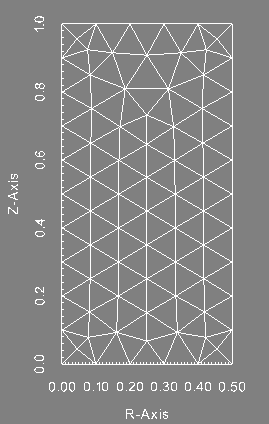
Finite element mesh (P1).
|
Information on the file condlim.f90
The initial conditions, boundary conditions and the forcing terms are set in the file condlim_test_21.f90. Here is a description of the subroutines and functions of interest.
-
The subroutine
init_velocity_pressure initializes the velocity field and the pressure at the time \(-dt\) and \(0\) with \(dt\) being the time step. This is done by using the functions vv_exact and pp_exact as follows: time = 0.d0
DO i= 1, SIZE(list_mode)
mode = list_mode(i)
DO j = 1, 6
!===velocity
un_m1(:,j,i) = vv_exact(j,mesh_f%rr,mode,time-dt)
un (:,j,i) = vv_exact(j,mesh_f%rr,mode,time)
END DO
DO j = 1, 2
!===pressure
pn_m2(:) = pp_exact(j,mesh_c%rr,mode,time-2*dt)
pn_m1 (:,j,i) = pp_exact(j,mesh_c%rr,mode,time-dt)
pn (:,j,i) = pp_exact(j,mesh_c%rr,mode,time)
phin_m1(:,j,i) = pn_m1(:,j,i) - pn_m2(:)
phin (:,j,i) = Pn (:,j,i) - pn_m1(:,j,i)
ENDDO
ENDDO
-
The function
init_level_set initializes the level set at the time \(-dt\) and \(0\) with \(dt\) being the time step. This is done by using the function level_set_exact as follows: time = 0.d0
DO i= 1, SIZE(list_mode)
mode = list_mode(i)
DO j = 1, 2
!===level_set
DO n = 1, inputs%nb_fluid -1
level_set_m1(n,:,j,i) = level_set_exact(n,j,vv_mesh%rr,mode,time-dt)
level_set (n,:,j,i) = level_set_exact(n,j,vv_mesh%rr,mode,time)
END DO
END DO
END DO
-
The function
vv_exact contains the analytical velocity field. It is used to initialize the velocity field and to impose Dirichlet boundary conditions on the velocity field. It is set to zero.
-
The function
pp_exact contains the analytical pressure. It is used to initialize the pressure to zero.
-
The function
level_set_exact is used to initialize the level set.
-
We define the level set of the mode and its TYPE (1 for cosine and 2 for sine) as follows:
IF (interface_nb==1) THEN
IF (m==0 .AND. TYPE ==1) THEN
vv = 1.d0 + rr(2,:)
ELSE IF (m==1 .AND. TYPE==1) THEN
vv = rr(1,:)
ELSE
vv = 0.d0
END IF
-
If more than one level set is considered, the computation is stopped.
ELSE
CALL error_petsc(' BUG in level_set_exact, we should compute only 1 level set')
END IF
RETURN
-
The function
source_in_NS_momentum computes the source term \(\bef\) of the Navier-Stokes equations.
-
The function
source_in_level_set computes the source term \(f_\varphi\) of the level set equations. It is equal to zero.
-
The subroutine
init_maxwell initializes the magnetic field at the time \(-dt\) and \(0\) with \(dt\) being the time step. It is done by using the function Hexact. time = -dt
DO k=1,6
DO i=1, SIZE(list_mode)
Hn1(:,k,i) = Hexact(H_mesh,k, H_mesh%rr, list_mode(i), mu_H_field, time)
IF (inputs%nb_dom_phi>0) THEN
IF (k<3) THEN
phin1(:,k,i) = Phiexact(k, phi_mesh%rr, list_mode(i) , mu_phi, time)
ENDIF
END IF
ENDDO
ENDDO
time = time + dt
DO k=1,6
DO i=1, SIZE(list_mode)
Hn(:,k,i) = Hexact(H_mesh,k, H_mesh%rr, list_mode(i), mu_H_field, time)
IF (inputs%nb_dom_phi>0) THEN
IF (k<3) THEN
phin(:,k,i) = Phiexact(k, phi_mesh%rr, list_mode(i), mu_phi, time)
ENDIF
END IF
ENDDO
ENDDO
-
The function
Hexact contains the analytical magnetic field. It is used to initialize the magnetic field and to impose Dirichlet boundary conditions on \(\textbf{H}\times\textbf{n}\) with \(\textbf{n}\) the outter normal vector. IF (m==0.AND. TYPE==1) THEN
vv = rr(1,:)**3
ELSE IF (m==0.AND.TYPE==5) THEN
vv = -4.d0*rr(1,:)**2*rr(2,:)
ELSE
vv = 0.d0
END IF
RETURN
-
The function
Phiexact contains the analytical scalar potential. It is not used in this test so we stop the code if this subroutine is called as follows: vv=0.d0
CALL error_petsc('Phiexact: should not be called for this test')
RETURN
-
The function
Jexact_gauss is used to define the source term \(\textbf{j}\). Since \(\partial_t (\mu^c \textbf{H})=0 \) and \( \bu=0 \), this source term has to satisfy the relation \(\textbf{j}= \ROT(\textbf{H}) \). IF(m==0.AND.TYPE==3) THEN
vv = 8.d0*rr(1)*rr(2)
ELSE
vv = 0.d0
END IF
RETURN
All the other subroutines present in the file condlim_test_21.f90 are not used in this test. We refer to the section Fortran file condlim.f90 for a description of all the subroutines of the condlim file.
Setting in the data file
We describe the data file of this test. It is called debug_data_test_21 and can be found in the following directory: ($SFEMaNS_DIR)/MHD_DATA_TEST_CONV_PETSC.
-
We use a formatted mesh by setting:
===Is mesh file formatted (true/false)?
.t.
-
The path and the name of the mesh are specified with the two following lines:
===Directory and name of mesh file
'.' 'Mesh_10_form.FEM'
-
We use one processor in the meridian section. It means the finite element mesh is not subdivised.
===Number of processors in meridian section
1
-
We solve the problem for \(4\) Fourier modes.
===Number of Fourier modes
1
-
We use \(1\) processors in Fourier space.
===Number of processors in Fourier space
1
-
We do not select specific Fourier modes to solve.
===Select Fourier modes? (true/false)
-
We approximate the MHD equations by setting:
===Problem type: (nst, mxw, mhd, fhd)
'mhd'
-
We do not restart the computations from previous results.
===Restart on velocity (true/false)
.f.
==Restart on magnetic field (true/false)
.f.
-
We use a time step of \(0.01\) and solve the problem over \(100\) time iterations.
===Time step and number of time iterations
.01d0, 100
-
We do not apply mass correction on the level set.
===Do we apply mass correction? (true/false)
-
We don't use a level set \(\varphi\) with values in \([0,1]\). So we do not kill the overshoot of the level set with respect of the interval \([0,1]\).
===Do we kill level set overshoot? (true/false)
-
We set the number of domains and their label, see the files associated to the generation of the mesh, where the code approximates the Navier-Stokes equations.
===Number of subdomains in Navier-Stokes mesh
1
===List of subdomains for Navier-Stokes mesh
1
-
We set the number of boundaries with Dirichlet conditions on the velocity field and give their respective labels.
===How many
boundary pieces
for full Dirichlet BCs on velocity?
3
===List of
boundary pieces
for full Dirichlet BCs on velocity
2 4 5
-
We use the momentum as dependent variable for the Navier-Stokes equations.
===Solve Navier-Stokes with u (true) or m (false)?
-
We use a BDF1 approximation of the time derivatives in the level set and momentum equations.
===Do we solve momentum with bdf2 (true/false)?
.f.
-
We set the kinetic Reynolds number \(\Re\).
===Reynolds number
250.d0
-
We use the entropy viscosity method to stabilize the level set equation.
===Use LES? (true/false)
.t.
-
We define the coefficient \(c_\text{e}\) of the entropy viscosity.
===Coefficient multiplying residual
0.d0
-
We give information on how to solve the matrix associated to the time marching of the velocity (or momentum in this case).
-
===Maximum number of iterations for velocity solver
100
-
===Relative tolerance for velocity solver
1.d-6
===Absolute tolerance for velocity solver
1.d-10
-
===Solver type for velocity (FGMRES, CG, ...)
GMRES
===Preconditionner type for velocity solver (HYPRE, JACOBI, MUMPS...)
MUMPS
-
We give information on how to solve the matrix associated to the time marching of the pressure.
-
===Maximum number of iterations for pressure solver
100
-
===Relative tolerance for pressure solver
1.d-6
===Absolute tolerance for pressure solver
1.d-10
-
===Solver type for pressure (FGMRES, CG, ...)
GMRES
===Preconditionner type for pressure solver (HYPRE, JACOBI, MUMPS...)
MUMPS
-
We give information on how to solve the mass matrix.
-
===Maximum number of iterations for mass matrix solver
100
-
===Relative tolerance for mass matrix solver
1.d-6
===Absolute tolerance for mass matrix solver
1.d-10
-
===Solver type for mass matrix (FGMRES, CG, ...)
CG
===Preconditionner type for mass matrix solver (HYPRE, JACOBI, MUMPS...)
MUMPS
-
We solve the level set equation.
===Is there a level set?
.t.
-
We want to consider one level set \(\varphi\), so we set: We note this test does not consider two immiscible fluids.
-
We do not use compression tools.
===Compression factor for level set
0.d0
-
We define the parameters \((\rho_1,\rho_2)\) used to reconstruct the density.
===Density of fluid 0, fluid 1, ...
1.d0 2.d0
-
We define the parameters \((\eta_1,\eta_2)\) used to reconstruct the dynamical viscosity.
===Dynamic viscosity of fluid 0, fluid 1, ...
1.d0 1.d0
-
We define a multiplier coefficient.
===multiplier for h_min for level set
1.d0
inputs%h_min_distance. It can be used in the condlim file to set the wideness of the initial interface. It is not used in this case as the level set does not represent an interface between two immiscible fluids.
-
We define the parameters \((\sigma_1,\sigma_2)\) used to reconstruct the electrical conductivity.
===Conductivity of fluid 0, fluid 1, ...
1.d0 2.d0
-
We use a linear reconstruction, meaning \(F(\varphi)=\varphi\).
===How are the variables reconstructed from the level set function? (lin, reg)
'lin'
-
We do not impose Dirichlet conditions on the level set.
===How many
boundary pieces
for Dirichlet BCs on level set?
0
-
We give information on how to solve the matrix associated to the time marching of the level set.
-
===Maximum number of iterations for level set solver
100
-
===Relative tolerance for level set solver
1.d-6
===Absolute tolerance for level set solver
1.d-10
-
===Solver type for level set (FGMRES, CG, ...)
GMRES
===Preconditionner type for level set solver (HYPRE, JACOBI, MUMPS...)
MUMPS
-
We use the magnetic field B as dependent variable for the Maxwell equations.
===Solve Maxwell with H (true) or B (false)?
-
We set the number of domains and their label, see the files associated to the generation of the mesh, where the code approximates the magnetic field.
===Number of subdomains in magnetic field (H) mesh
1
===List of subdomains for magnetic field (H) mesh
1
-
We set the number of interface in H_mesh.
===Number of interfaces in H mesh
0
-
We set the number of boundaries with Dirichlet conditions on the magnetic field and give their respective labels.
===Number of Dirichlet sides for Hxn
3
===List of Dirichlet sides for Hxn
5 2 4
-
We set the magnetic permeability in each domains where the magnetic field is approximated.
===Permeability in the conductive part (1:nb_dom_H)
1.d0
-
We set the conductivity in each domains where the magnetic field is approximated.
===Conductivity in the conductive part (1:nb_dom_H)
1.d0
-
We set the type of finite element used to approximate the magnetic field.
===Type of finite element for magnetic field
2
-
We set the magnetic Reynolds number \(\Rm\).
===Magnetic Reynolds number
2.d0
-
We set stabilization coefficient for the divergence of the magnetic field and the penalty of the Dirichlet and interface terms.
===Stabilization coefficient (divergence)
1.d0
===Stabilization coefficient for Dirichlet H and/or interface H/H
1.d0
-
We set the number of domains and their label, see the files associated to the generation of the mesh, where the code approximates the scalar potential.
===Number of subdomains in magnetic potential (phi) mesh
0
-
We give information on how to solve the matrix associated to the time marching of the Maxwell equations.
-
===Maximum number of iterations for Maxwell solver
100
-
===Relative tolerance for Maxwell solver
1.d-6
===Absolute tolerance for Maxwell solver
1.d-10
-
===Solver type for Maxwell (FGMRES, CG, ...)
GMRES
===Preconditionner type for Maxwell solver (HYPRE, JACOBI, MUMPS...)
MUMPS
-
To get the total elapse time and the average time in loop minus initialization, we write:
===Verbose timing? (true/false)
.t.
lis when you run the shell debug_SFEMaNS_template.
Outputs and value of reference
The outputs of this test are computed with the file post_processing_debug.f90 that can be found in the following directory: ($SFEMaNS_DIR)/MHD_DATA_TEST_CONV_PETSC.
To check the well behavior of the code, we compute four quantities:
-
The L2 norm of the error on the velocity field.
-
The H1 norm of the error on the velocity field.
-
The L2 norm of the error on the level set.
-
The L2 norm of the error on the the magnetic field.
These quantities are computed at the final time \(t=1\). They are compared to reference values to attest of the correctness of the code. These values of reference are in the last lines of the file debug_data_test_21 in the directory ($SFEMaNS_DIR)/MHD_DATA_TEST_CONV_PETSC. They are equal to:
============================================
(Mesh_10_form.FEM)
===Reference results
1.3906183032940818E-005 L2 error on velocity
3.0086983840053983E-006 L2 error on pressure
6.7632134413749881E-006 L2 error on level set
1.8335168044284966E-005 L2 error on Magnetic field
To conclude this test, we show the profile of the approximated level set, density, pressure and velocity magnitude at the final time. These figures are done in the plane \(y=0\) which is the union of the half plane \(\theta=0\) and \(\theta=\pi\).
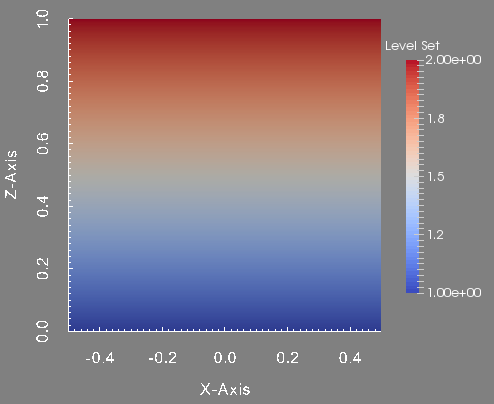
Level set in the plane plane y=0.
|
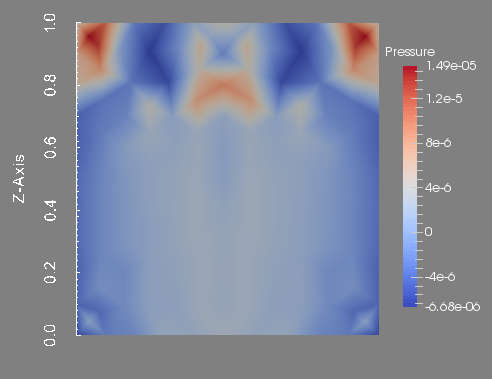
Presure in the plane plane y=0.
|
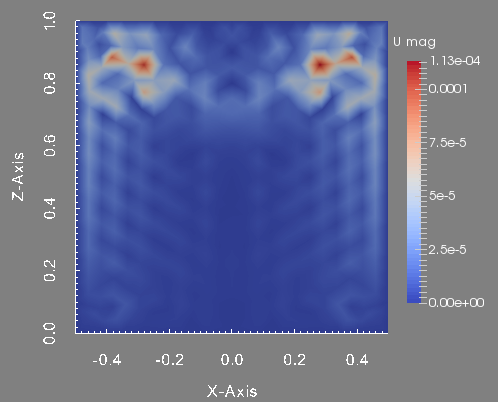
Velocity magnitude in the plane plane y=0.
|
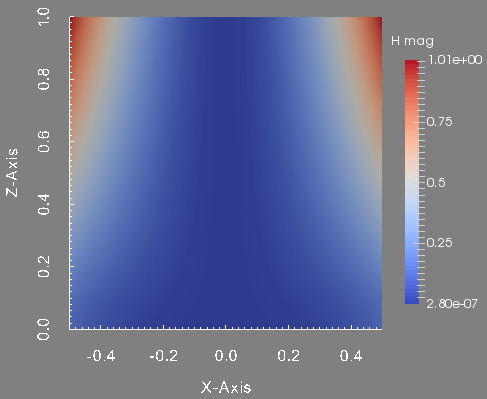
Magnetic field magnitude in the plane plane y=0.
|






